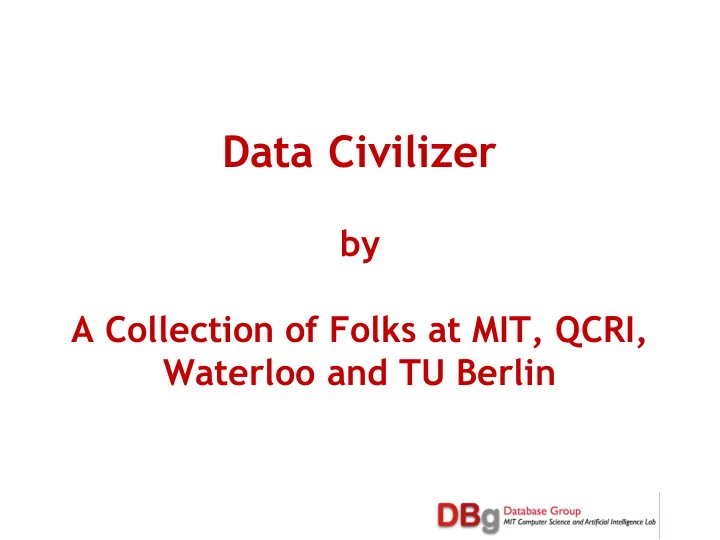

Data Civilizer by A Collection of Folks at MIT, QCRI, Waterloo and TU Berlin
The Problem •Mark Schreiber (Merck) reports that his data scientists spend 98% of their time • Locating data of interest • Accessing data of interest • Cleaning and transforming data of interest •I.e. 39 hours a week of “mung work” and 1 hour a week doing the job for which they were hired •NOBODY reports less than 80% mung work!
Data Civilizer •Goal is to make Mark Schreiber happy i.e. drive down the 98% •
Data Civilizer •Enterprise crawling to enable next steps •Data Discovery • Find tables of interest to a data scientist •Transformations • Syntactic (e.g. European dates to US dates) • Semantic (e.g. Merck has five different ID systems for chemical compounds) •Join path identification and choice •Data cleaning
Our Demo •Enterprise crawling to enable next steps •Data Discovery • Find tables of interest to a data scientist •Transformations • Syntactic (e.g. European dates to US dates) • Semantic (e.g. Merck has five different ID systems for chemical compounds) •Join path identification and choice •Data cleaning
Context •Merck has ~4000 Oracle data bases •Plus a data lake •Plus untold files •Plus untold spreadsheets •Plus they are interested in public data from the web •Any solution has to work at scale!!!!!!
We Can’t Do a Merck Demo •They are protective of their data • We haven’t cracked the problem of getting access to much of their data •Ergo we don’t have a suitable crawler
Instead….. • We are using the MIT Data Warehouse 2400 tables in an Oracle database • Students, courses, buildings, … • 160 are “semi-public” • • Campus personal have ad-hoc questions • For example: How many employees work in degree granting • departments?
Analysts spend more time finding relevant data than analyzing it
Data Civilizer Discovery Module • Goal: Find data relevant to the question at hand • Challenges of scale and varied discovery needs • Approach to large scale data discovery: • Data Summarization • Mining relationships: Linkage graph • Discovery algebra : express different queries
Data Civilizer Discovery Module • Goal: Find data relevant to the question at hand • Challenge: scale and varied discovery needs • Approach to large scale data discovery: • Data Summarization • Mining relationships: Linkage graph • Discovery algebra : express different queries
Data Civilizer Discovery Module • Goal: Find data relevant to the question at hand • Challenge: scale and varied discovery needs • Approach to large scale data discovery: • Data Summarization • Mining relationships: Linkage graph • Discovery algebra : express different queries
Demo
Which Join Path is the Best? •Each join path leads to a different view • different size – coverage • different quality – cleanliness •Combine the two metrics to pick the path •But, how to estimate cleanliness?
Estimating cleanliness •Estimate the cleanliness of source data • Outlier detection • Check integrity constraints • New method based on relationships in linkage graph •Propagate cleanliness from source to view
View Cleaning with a Budget •Where to clean • Clean sources may waste budget on irrelevant cells • Clean view may waste budget on duplicates • Only clean source cells that affect the view •Which cell to clean? • Clean cells with the biggest impact to the view. • Leverage cleanliness propagation to calculate the impact
Demo
What’s Coming •Eye Candy!!!!! •Semantic transformations • Using Data Xformer (CIDR 2015, SIGMOD 2015) • Inside the firewall as well as out on the web •Partner to get syntactic ones •Workflow system • Data Civilizer has to be iterative
What’s Coming •Join path clustering • To identify ones with the same semantics • Will require human input! •Data cleaning cannot be totally manual • QCRI has done a lot of work in this area • We have a bunch of ideas on how to move forward •Provenance • Mark is interested in what is derived from what
What’s Coming •Cannot copy all data of interest into a data lake • There is simply too much of it •Have to access data “in situ” and on demand • Requires a polystore • And we have built one (BigDAWG)
Stay Tuned for a Complete System
Recommend
More recommend